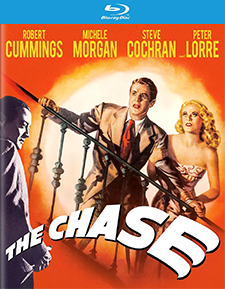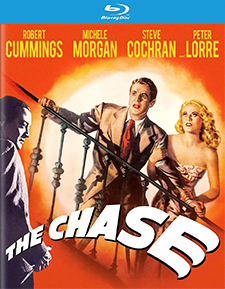Chase, The (1946) (Blu-ray Review)

Director
Arthur RipleyRelease Date(s)
1946 (June 4, 2024)Studio(s)
Nero Films/United Artists (Kino Lorber Studio Classics)- Film/Program Grade: B
- Video Grade: A-
- Audio Grade: A-
- Extras Grade: B
Review
Genuinely bizarre, The Chase (1946) is an independently-produced film noir seemingly made by hands with little familiarity with the genre. Adapted by Philip Yordan from Cornell Woolrich’s 1944 novel The Black Path of Fear, the film is decidedly off-kilter throughout, revolving around a spectacularly strange plot twist about two-thirds of the way through. Yet, audacious as that is, it’s a plot twist generating more plot holes than anything else. Some genre scholars admire the picture’s dream-like air of unreality but, for me, its outrageous qualities seem the result of inexperience and ineptitude rather than commendable ambition.
World War II Navy veteran Chuck Scott (Bob Cummings) is penniless, first seen gazing at breakfast being prepared through a Miami restaurant’s front window. On that same sidewalk he finds a wallet with almost $200 in cash. After treating himself to a meal, he resolves to return it to its owner.
The wallet, it turns out, belongs to sadistic gangster Eddie Roman (Steve Cochran), who lives in a palatial mansion with equally sadistic right-hand man Gino (Peter Lorre), intimidating butler Job (James Westerfield), and his glamorously beautiful but frightened wife, Lorna (Michèle Morgan), virtually held prisoner by Roman. The gangster is taken with Chuck’s resolute honesty and unflinching manner, immediately hiring him on as his chauffeur. Considering both Roman and Gino are completely nuts this is not the wisest of moves. Roman is introduced threatening his female barber Joe Pesci-style and brutally striking his manicurist, and later he murders shipbuilder Emmerich Johnson (Lloyd Corrigan) by luring him down to Roman’s wine cellar where a large cat (never seen) rips him to pieces.
Lorna offers Chuck $1,000 to help her escape across the Gulf to Havana, and since the two are already falling in love, Chuck is happy to oblige, though he’s extraordinarily careless making the arrangements, even calling Lorna at home and, on the line, telling her all about the steamship tickets he’s purchased for them.
Director Arthur Ripley’s background was primarily in silent and early talkie comedies, including as a stint as a gag writer for Mack Sennett, screenplays for Frank Capra’s late silents, and still later he was the credited director on several W.C. Fields two-reelers for Sennett in the early 1930s, The Pharmacist and The Barber Shop. He directed lots of shorts but few feature films, less than half a dozen, the first being a co-directing job with Edgar G. Ulmer, Prisoner of Japan (1942), followed by the independently-made noir Voice in the Wind (1944), his last credit prior to The Chase.
Ripley’s directorial style is peculiar to say the least. Large swaths are photographed (by Richard Fryer, another old-timer who in the sound era mostly shot serials) in the manner of silent films, with long, static, contemplative shots heavily underscored by Michel Michelet’s overemphatic, piano-heavy music: Lorna gazing wistfully across the Gulf, Chuck peering through a porthole. At other times Fryer’s serial experience contrasts the methodical static scenes with serial-like action: an out-of-nowhere plot device has chauffeur Chuck surprised to discover that Roman’s sedan is equipped with a backseat accelerator, allowing him to push the car past 100mph while whomever is at the wheel can only steer at bullet-like speeds. This, like so much of the picture, strains credibility well past the breaking point. The film was not cheap and probably in the $500,000-$800,000 range, with an especially elaborate yet barely-glimpsed mansion set for the gangster, and big nightclub scenes with lots of extras.
The Chase’s reputation rests largely on its loopy plot and its weird plot twist that I won’t reveal here, except to point out that, while impressively strange, makes little sense; the already unreal story going completely off the rails. The revelation it presents is full of holes—showing us things its hero could not have seen or known or anticipated. Supposed “reality” is just as nuts as the picture’s “unreality.” Why does Roman keep a dangerous cat in the wine cellar? What’s up with that crazy, insanely dangerous car?
One suspects the film needed some degree of retooling to be made releasable. For instance, the character played by glamorous French import Michèle Morgan (who lived to the ripe-old age of 96 or 24; look it up) simply shows up in an after-dinner scene with no real introduction, certainly without a scene properly introducing Lorna to Chuck, a scene that would seem essential to the story. Don Wilson, the famous announcer of the Jack Benny radio show, appears early in one scene but has no lines; virtually an extra, radio fans probably would not have recognized him, then again very late in the story to provide a clumsy deus ex machina.
The undervalued Bob Cummings is quite good, considering the pretzel-like twists his character is put through, and Michèle Morgan is undeniably gorgeous. Cochran and Lorre are appropriately maniacal though neither part could’ve taxed either actor very hard.
For decades The Chase was available on home video only in the form of dreadful, unwatchable public domain copies. Kino’s release utilizes a much superior 2012 restoration by the UCLA Film & Television Archive, partly funded by French organizations, presumably for Michèle Morgan’s participation in the picture. The black-and-white, 1.37:1 standard picture has a few imperfections but is quite pleasing overall, as is the DTS-HD Master Audio (2.0 mono), supported by optional English subtitles. Region “A” encoded.
The interesting extra features include two radio adaptations of Woolrich’s story, starring Cary Grant and Brian Donlevy. A new audio commentary by Canadian filmmaker Guy Maddin (Tales from the Gimli Hospital, The Saddest Music in the World) is full of admiration; The Chase’s silent era influences clearly part of the attraction, presumably.
For film noir buffs, The Chase is required viewing; others may find it too incredible to be believed on any level, or they may find it a fascinating puzzle—the kind of puzzle missing several pieces with pieces from other puzzles tossed into the box.
- Stuart Galbraith IV

